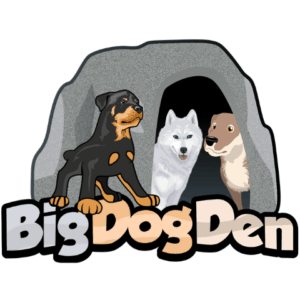There is a lot of misinformation out there when it comes to the subject of big dogs. I’m glad you’ve landed here to find accurate information, welcome to the Big Dog Den! In this article, we’ll separate fact from myth and discover how to train a big dog to be gentle with puppies, babies, and other animals that are smaller than the dog. I won’t lie, there is certainly some controversy out there when it comes to large dog breeds. There’s also some bias. Today we’ll be dealing with facts.
Keep reading to learn:
- If Big Dogs are Naturally Gentle
- How to Properly Introduce a Big Dog to Puppies
- What You MUST Know About Big Dogs and Children
- How Training and Socializing Your Big Dog are Key Elements to Success
- Whether Big Dogs can Get Along with Small Animals
…and so much more!
When gathering my information to present here today, I have combined what I’ve learned through owning several Rottweilers through the years who’ve topped 120 pounds (54kg) with what the experts teach to confidently share accurate information. These experts include, but aren’t limited to:
- The American Kennel Club (AKC)
- The Merck Veterinary Manual (MVM)
- Pet Md
- Various Large Breed Dog Clubs of America
- My Dog’s Veterinarian
- Cesar Millan, Dog Behavior Specialist
Plus countless interviews I’ve conducted with other Big Dog Owners. You can be assured you will receive the latest and most accurate information right here and right now! Along the way, I’ll answer the most frequently asked questions (FAQ) I receive pertaining to big dogs getting along with smaller animals and humans and throw in some interesting facts you may not have known. So let’s get started, we’ve got a lot of information to sort through…
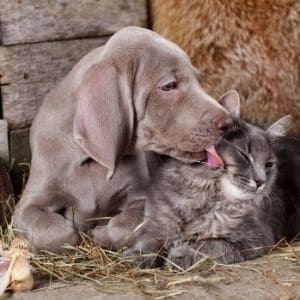
FAQ: Do big dogs know how to be gentle with puppies?
In researching a different article for the Big Dog Den I discovered that big dogs do know just how big they are! One place we see evidence of this is in their interactions with smaller dogs and yes, even puppies. A healthy big dog will likely adjust his (or her) behavior appropriately to have encounters with animals smaller than themselves.
You can enhance the experiences your big dog will have with other humans and animals, as well. You’ll do this through training and through ensuring your big dog is well-socialized. The more people, animals and scenarios your dog encounters on a regular basis, the more comfortable he (or she) will become.
Training Your Big Dog to be Gentle
The time to begin training your dog is the day after he (or she) arrives at your home. Gentleness doesn’t necessarily have its own training regime. Gentleness should be incorporated into all your training. This is done by first being gentle yourself, as your big dog will pick up cues from you according to your voice tone and your body language.
As your dog learns to master the 5 Basic Commands, you’ll be able to add a vocal command (in unison with a hand gesture) that tells your dog it’s time to exhibit gentleness in his (or her) behavior.
The 5 Basic Commands are:
- Come!
- Heel!
- Sit!
- Down!
- Stay!
When it comes to teaching your dog to be gentle, select a one or two-word vocal command to use consistently. By adulthood, your dog will have come to understand 150-250 words and/or gestures. I simply use “Be Gentle!” as a vocal cue.
Adding a hand gesture to a vocal command is helpful, too. For instance, when my dog is being introduced to a smaller animal, I give the “Be Gentle” vocal command in combination with a petting hand gesture. My dog has so learned my technique that often, only the hand gesture is needed for any of the commands I give.
I don’t wait until my dog is meeting new people or animals to issue the gentle command. If he doesn’t hear the word often or have the opportunity to practice exhibiting gentleness, he will not be very good at obeying the command.
Instead, we practice gentleness often and in many different ways. You can too! When your dog is being gentle and loving toward you, verbally recognize him (or her). For instance, when you see your dog being gentle, say something like, “What a good boy (or girl)! You’re being so gentle!” Remember to say the word in conjunction with a hand gesture.
Other ways you can work on gentleness training are:
- Issue the command to be gentle when your dog is getting a treat.
- Encourage gentle behaviors during grooming time and reward your dog’s efforts.
- Utilize the “gentle” command at the end of playtime or exercise time to wind your big dog down after vigorous activity.
Using the command often and consistently will have your dog ready to respond when you issue the command when introducing your dog to humans or animals.
Socializing Your Big Dog
I mentioned socialization earlier, and it is exactly what it sounds like it would be. The earlier in your big dog’s life you get him (or her) out among other animals the quicker your dog will become comfortable when encountering dogs, other animals, and even humans!
There are a plethora of options for socializing your dog. Some great places to check out are:
- Your Local Dog Park: It’s free, and you are sure to encounter like-minded people out with their dogs doing the exact same thing. Your big dog is sure to find a new friend there, and you might too!
- Doggie Day Care: With some careful shopping around, you’ll be able to find a Doggy Daycare for a reasonable price. My big dog goes a couple of days a week, and I couldn’t be more pleased with how well he does there!
- Friends, Neighbors, or Family: If you have friends or family who own animals, make a play date for your pets!
Encourage your dog’s “meet and greet” by keeping your tone pleasant while keeping an eye on his (or her) body language, as well as on the body language of the other animals present. Remove neither muzzle nor leash (if appropriate) until you see calm and relaxed animal behaviors.
HELPFUL HINT: When dogs are at the dog park or other places designated for frolicking animals, it is best they are unleashed and not wearing Canine Clothing. The leash could pose a risk of strangulation, and Canine Clothing inhibits the body language dogs use to communicate with one another.
Remembering that dogs think differently than we do is key in all training. Keep in mind that your dog is territorial and protective toward you. Be sure your body language, as well as your voice, is setting a pleasant and encouraging “atmosphere”. When introducing your big dog to new animals, DO NOT…
…force them into close proximity
…surprise either animal.
…remove any leashes involved too soon.
Introducing Your Big Dog to a Puppy (or Puppies)
Whether you are bringing a new puppy into your home or visiting a friend who has a puppy, you’ll begin the introduction just as I described above. Have your dog on a leash, wearing a muzzle. Have your dog sit, and issue the command you’ve designated for “gentle“. Bring the puppy close to your dog and allow your dog to give the puppy a thorough sniffing, as this is how dogs “investigate”.
Keep your tone gentle and encouraging, and keep an eye on your dog’s body language. If your dog shows any signs of aggression or acts in any other way than gentle, remove him (or her) immediately and try again at another time.
It’s important to know that punishment isn’t effective when socializing your dog. You want your dog to connect other animals (and humans) with pleasure in his (or her) mind. If you punish your dog for inappropriate behavior during socialization, he will connect the experience to unpleasantness, and will not be in a hurry to have another social encounter.
Gradually increasing your big dog to new social scenarios will gradually increase his (or her) comfort level. All aspects of training your dog will require patience and repetition! Reward all efforts your dog makes with praise (or treats) and remember when things don’t go as planned, redirect or remove your dog and try again another time.

FAQ: I’m having a baby. Can I keep my Big Dog?
Before we delve into this subject, a disclaimer is warranted. Never leave a baby or toddler unattended with a big dog. Although the risk of a dog bite is low, it must be considered (especially with toddlers, who are renowned for poking and pulling hair). The bigger risk with an infant could be suffocation should your dog “cuddle up” to the baby. That being said, you can absolutely keep your big dog when bringing a new baby into your home!
Introducing Your Big Dog to a Baby
If possible, two humans should be present to participate in introducing your big dog to a baby. One person to keep control over the dog and one person to hold the baby. Have the dog leashed and muzzled as you should do with all new introductions.
With the person holding the baby seated, the other person can lead the dog to the baby and issue the command for gentle. Allow the dog to sniff the baby. If the dog becomes excited (and sometimes they do) pull the dog back a bit and reissue your designated command for gentle. If the command is effective, allow the dog to remain near the baby for a few minutes. Reward your dog’s good behavior and then redirect him (or her) away from the baby.
Several short introductory sessions should be made so that your dog can adjust to the different sounds and smells coming from the baby.
If your big dog has any reaction to the baby other than a gentle curiosity, or if your dog exhibits any warning signs in his (or her) body language (keep reading to learn the signs), remove the dog immediately and try again later. When you remove the dog from any situation where his (or her) behavior displeases you, the dog realizes that to be where you are, his behavior has to be pleasing to you. Believe it or not, that is always your dog’s primary goal… to please you.
When you’re comfortable with your dog’s behavior near the baby, you can remove the leash and muzzle. However, never remove adult supervision from the room. And don’t forget to reward your dog’s good behavior!
Big Dog and Small Children Safety
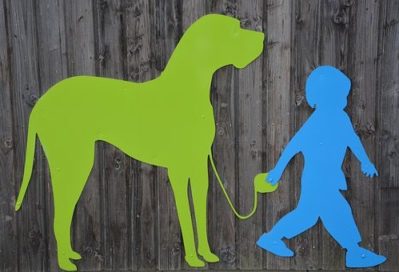
Let’s recap what we have learned so far about big dogs and small humans. Do not leave them together without adult supervision. Before you come to the end of this article, you’ll discover that all dogs have the capacity to become aggressive. Furthermore, all children have the capacity to not follow the rules occasionally. Combining these two facts without adult supervision can have tragic consequences, no matter how “well-behaved” either is “usually”.
Make sure all children who will interact with your big dog frequently know the words and gestures for the 5 Basic Commands. A well-trained dog will be as responsive to a 5-year-old’s commands as he (or she) is to your commands. Additionally, enforce a “no rough-housing” rule. Many dog bites on children began with innocent playtime that got too rough. That makes a lot of sense knowing that both children and dogs are subject to becoming over-excited or over-stimulated, whichever term you prefer.
Children love walking the dog, no doubt about it! However, this is another place safety can be an issue. Some of our big dogs weigh well over 100 pounds (45kg) and most young children do not. Do not let a small child walk a big dog until you’re satisfied the youth has full control over the dog at the other end of the leash.
If walking the dog is a job you’ll delegate to your child to help teach him (or her) responsibility through caring for a pet, I applaud you! Children thrive when they have responsibilities, and bonding with the family dog is beneficial to child and dog alike. Just be sure you train your child on how to walk the dog properly. This human training should come from example by having the child accompany you on several dog walking treks, and by letting the child practice proper leash “etiquette” in your yard or in a park so they are away from traffic while adjusting to one another’s walking methods, pace, and duration for the walk.

FAQ: Are big dogs gentle with cats?
The most honest answer I can give is this one: Not all big dogs (or any sized dogs, for that matter) will get along well with cats. It’s an age-old dilemma. The cartoon characters, Tom and Jerry taught us that, LOL! However, many, many dogs do get along fine with cats! My dog certainly does! Whether or not your dog will like cats has a lot to do with the circumstances surrounding their introduction. If you’ve had your dog since he (or she) was a pup, the chance of him getting along great with cats increases significantly.
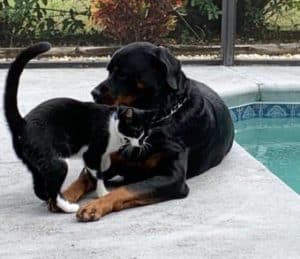
How to Introduce Your Big Dog to Smaller Animals
I was a little apprehensive when we made the decision to bring a kitten into the home we share with our massive Rottweiler, I won’t lie! But I was confident that my dog was well-socialized from his time (and behavior) at Doggy Day Care and I knew he was well trained because I trained him myself. You can use the method I used for introducing my dog to the new kitten with any small animal. I know people with big dogs who also own ferrets, chickens, and even pot-bellied pigs! The smaller animal names are different, but the introduction method is the same. This is how I introduced my Maximus to new kitten, Oreo:
Step One: The “Meet & Greet”
With his leash and muzzle in place, I approached the kitten with the dog. My husband held the kitten for an added measure of safety, We spoke gently to the dog while he had an “introductory sniffing”. My dog was calm and exhibited no body-language warning signs of aggression (which we will cover momentarily). His good behavior was rewarded and the leash and muzzle were removed.
Step Two: Supervised Visitation
For a period of time, we only allowed the two animals to interact when we were there to supervise. Otherwise, we kept them separated. Little by little, we saw the two begin to relax around each other and it wasn’t long before they began exhibiting some playful body language.
Step Three: Watch the Friendship Develop!
Right before my eyes, a friendship was formed! My 120 pound Rottweiler and my 2 Pound kitty have become inseparable at home. I enjoy watching my powerful dog playing gently with his little buddy, and I enjoy watching the tiny kitten think he has the upper hand!
To reiterate: If your dog exhibits any undesirable behavior when being introduced to other animals (or humans) simply remove him (or her) and try again at a different time. Only positive reinforcement is effective in training your dog to be social. Harsh punishment will be counter-productive in the long run, I assure you.
Now don’t get me wrong, a measure of discipline is necessary for dogs, especially ones who will grow to massive proportions! Understanding the difference between discipline and punishment is important. Punishment involves things like striking your dog (something that’s NEVER necessary) or locking him (or her) in a cage for extended periods of time (they won’t remember why they’re in the cage in the first place). Discipline is a sharp and authoritative “NO!” command issued in union with removing the dog from the situation for as little as 5 minutes.
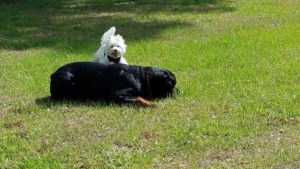
FAQ: What if my big dog reacts aggressively?
All dogs carry the potential to become aggressive! Dogs are territorial. They are protective of their home, their land, and of their family (human or canine). They are capable of being startled and capable of fear. All of these elements can trigger aggression in any sized dog.
Additionally, a dog who is injured COULD respond with aggression. When we are startled, hurt, or afraid, we may jump, run, or cry out. When a dog is startled or afraid or otherwise feels threatened, they bite. It is their first, and really their only, line of defense.
However, contrary to popular opinion, this aggression is never unprovoked and dogs don’t just attack “out of the blue”. This is why I always mention how important it is to observe your dog’s body language. It is your dog’s primary method of communication and I assure you, he (or she) has already learned your body language.
Anxiety will manifest in your dog’s body language before he or she lashes out. Knowing what signs to watch for in your dog when introducing him (or her) to the unfamiliar will help you to avoid any unnecessary ado… or worse. Your dog may not display all the warning signs of potential aggressive behavior(s) on the following list, but I assure you if your dog’s agitation level is escalating, you’re going to notice at least one of these warning signs:
Warning Signs of Aggression in Dogs:
- An Intense Stare
- Ears That are Laid Flat Back (or Standing Straight Up Stiffly)
- Bared Teeth and/or a Curled Lip
- A “Guard Stance”- Head Lower than Shoulders
- Hackles are Raised- Hair on Back and Neck Stand Straight Up
- A Low and Glutteral Growl
- Whale Eyes (The Whites of the Dog’s Eyes Will Show).
Why a Muzzle is Important: DON’T SCROLL PAST THIS SECTION
I realize that strapping a muzzle on your beloved four-legged companion might cause you some unease. To you, he (or she) is your big baby. Your special “little” schnook-ums. You can’t imagine him (or her) ever hurting another animal or a small human! But I have to be honest here and say, it happens! Even with beloved dogs who’ve never manifested an aggressive behavior in his whole life.
There are times when a muzzle is definitely warranted. A muzzle on your big dog doesn’t mean your dog is mean. Rather, a muzzle shows that you are a responsible pet owner and realize you know your dog’s strength, should an introduction go from pleasant to “iffy”. Additionally, a muzzle shows you understand and respect the fact that some people won’t be comfortable around your dog simply because of his (or her) massive size.
Furthermore, a muzzle protects your big dog, too. How you ask… I’ll tell you! Should your Big Dog bite a human being or even another animal, he (or she) may be added to the “bad dog” list in your community, and that is a “best-case scenario”. In a worst-case scenario, your dog could be euthanized and there wouldn’t be a thing you could do to stop it from happening, no matter how long you’ve loved the dog or how good his (or her) behavior has been in the past.
Always use a muzzle in the following circumstances:
- When entering a New Environment like a new dog park, neighborhood, etc
- When entering a Public Building, including doggie daycare, the groomer, pet-friendly stores, etc
- When in Highly Populated or Congested Areas: Carnivals, fairs and crowded sidewalks or buses may not be overwhelming to you, but they sure can be to your big dog!
- When your big dog is Among Many Animals: When your pooch is surrounded by other animals, especially unfamiliar ones, utilize the “Better Safe Than Sorry” rule of thumb! Muzzle him (or her).
- In People Parks: No matter how social or people-loving your big dog is, you have no assurance the people you encounter while out are going to be dog-lovers.
- At Campgrounds or Hotels: When making reservations, inquire about their pet policies. Then, muzzle your dog when in any public area of your lodging facilities.
- On the Beach: You’ll probably have the opportunity to remove his muzzle for that game of frisbee or frolicking in the waves, but at least arrive at the beach with your dog muzzled until you’ve determined it is safe to remove it.
- On Hiking Trails on Jogging Paths: If there are other humans on your trail or path, keep that muzzle on! Sudden and quick movements, along with unexpected ones are things that can “trigger” your big dog’s protective instincts. Strangers popping out on a trail or jogging quickly up behind you may not bode well with your dog.
- Around Small Children: I’ll say that again. Around Small Children. Your big dog is stronger than he (or she) realizes and kids are just… well… kids. They can play rough without realizing. Some kids poke and squeeze. Some have loud voices and can startle your dog. And some kids (and adults) your big dog just won’t like for reasons you will never know.
- In Your Home when entertaining guests. This may seem like a ludicrous notion to you, but here at the Big Dog Den, we recommend it anyway! You can take the muzzle off when all humans and animals are comfortable in the knowledge that the potential for aggression has passed.
The best way to handle a miscommunication between your big dog and a human or other animal that could get ugly is to avoid one! Follow all the techniques you’ve discovered here today, and muzzle your dog for introductions and initial interactions he (or she) will have.
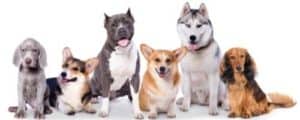
I hope today’s article has effectively answered any questions you may have had regarding big dogs with smaller animals and humans. As you have discovered, it is possible, with proper training and socialization, for your dog to be in harmony with all the souls he (or she) encounters along the way. Doing the research n this subject tells me you’re a responsible dog owner… I like that about you! Together, we can give big dogs the good reputation they merit, instead of the stereotypes sensationalized in the media. Thanks for dropping by the Big Dog Den today, I hope to “see” you again soon!
*This article has been reviewed in accordance with our editorial policy.
How to Teach a Big Dog to be Gentle with a Puppy or a Baby. There is certainly some controversy when it comes to large dog breeds. There’s also some bias…we’ll be dealing with facts.
